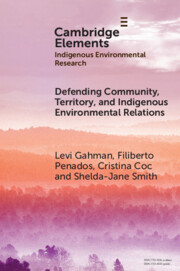Refine search
Actions for selected content:
743 results
6 - Reversal, Reciprocity, and Revenge in Sectarian Fantasies of Eschatological Violence
-
- Book:
- Violence, Power, and Society in the Dead Sea Scrolls
- Published online:
- 29 September 2025
- Print publication:
- 16 October 2025, pp 164-197
-
- Chapter
- Export citation
3 - The Making of a Global Warrior
-
- Book:
- Armed Internationalists
- Published online:
- 19 September 2025
- Print publication:
- 09 October 2025, pp 59-96
-
- Chapter
- Export citation
2 - Ranching the Amazon
- from Part II - Ranching-Grabbing Brazil
-
- Book:
- Clearcut
- Published online:
- 03 October 2025
- Print publication:
- 02 October 2025, pp 33-57
-
- Chapter
-
- You have access
- Open access
- HTML
- Export citation
7 - Tracking the Rising Role of Organized Crime in Gold Mining
- from Part III - Narco-Gold Mining in the Amazon
-
- Book:
- Clearcut
- Published online:
- 03 October 2025
- Print publication:
- 02 October 2025, pp 140-160
-
- Chapter
-
- You have access
- Open access
- HTML
- Export citation
5 - Gold Mining, Illegality, and Deforestation in the Amazon
- from Part III - Narco-Gold Mining in the Amazon
-
- Book:
- Clearcut
- Published online:
- 03 October 2025
- Print publication:
- 02 October 2025, pp 101-116
-
- Chapter
-
- You have access
- Open access
- HTML
- Export citation
11 - The International System, Global Crises, and Deforestation
- from Part V - Global Deforestation
-
- Book:
- Clearcut
- Published online:
- 03 October 2025
- Print publication:
- 02 October 2025, pp 241-255
-
- Chapter
-
- You have access
- Open access
- HTML
- Export citation
One Cross, Two Continents: How Catholic Women’s Resistance in Mexico Inspired Their Spanish Counterparts (1926–1936)
-
- Journal:
- Comparative Studies in Society and History , First View
- Published online by Cambridge University Press:
- 26 September 2025, pp. 1-22
-
- Article
-
- You have access
- Open access
- HTML
- Export citation
2 - Beyond Here Lies Somethin’
-
-
- Book:
- Reckoning with Law in Excess
- Published online:
- 09 September 2025
- Print publication:
- 25 September 2025, pp 56-75
-
- Chapter
-
- You have access
- Open access
- HTML
- Export citation
Occurrence of mastitis pathogens and their antibiotic resistance in dairy cows in Slovakia
-
- Journal:
- Journal of Dairy Research , First View
- Published online by Cambridge University Press:
- 19 September 2025, pp. 1-4
-
- Article
- Export citation
Chapter 4 - Sovereignty and Security Dilemmas in William Shakespeare’s History Plays
-
- Book:
- Security, Fiscal Policy, and Sovereignty in Renaissance English Literature
- Published online:
- 04 September 2025
- Print publication:
- 18 September 2025, pp 92-126
-
- Chapter
- Export citation
8 - Material Language Culture between Ideologies of Fixity and Resistance
- from Part II - Constructing Languages through Discourses on Belonging, Prestige, and Materiality
-
- Book:
- Liquid Languages
- Published online:
- 28 July 2025
- Print publication:
- 14 August 2025, pp 160-194
-
- Chapter
- Export citation

Defending Community, Territory, and Indigenous Environmental Relations
-
- Published online:
- 08 August 2025
- Print publication:
- 11 September 2025
-
- Element
-
- You have access
- Open access
- HTML
- Export citation
Nutritional status, body indices, and somatotype in Aymara and Quechua children from high Andean areas of Peru
-
- Journal:
- Journal of Nutritional Science / Volume 14 / 2025
- Published online by Cambridge University Press:
- 01 August 2025, e55
-
- Article
-
- You have access
- Open access
- HTML
- Export citation
2 - Fourteen Thousand Black Infantrymen
-
- Book:
- A Black Army
- Published online:
- 16 June 2025
- Print publication:
- 17 July 2025, pp 38-63
-
- Chapter
- Export citation
3 - Separated by the Color Line
-
- Book:
- A Black Army
- Published online:
- 16 June 2025
- Print publication:
- 17 July 2025, pp 64-76
-
- Chapter
- Export citation
Chapter 3.6 - Temperature and Humidity
- from Sec 3 - Physics
-
- Book:
- Dr Podcast Scripts for the Primary FRCA
- Published online:
- 19 June 2025
- Print publication:
- 03 July 2025, pp 371-382
-
- Chapter
- Export citation
11 - Global Legal Pluralism and the Rights of Nature
-
-
- Book:
- Legal Heterodoxy in the Global South
- Published online:
- 19 June 2025
- Print publication:
- 03 July 2025, pp 339-376
-
- Chapter
-
- You have access
- Open access
- HTML
- Export citation
Transgenerational effect of Cordyceps fumosorosea (Wize) on demographic parameters and detoxifying enzymes of Spodoptera frugiperda (Smith)
-
- Journal:
- Bulletin of Entomological Research / Volume 115 / Issue 5 / October 2025
- Published online by Cambridge University Press:
- 02 July 2025, pp. 660-671
-
- Article
- Export citation
2 - ‘You Can Do Nothing; He Is a Soldier with Gun, and He Is Controlling You’: The Masculinised Body under Occupation
-
- Book:
- Occupier and Occupied
- Published online:
- 15 June 2025
- Print publication:
- 26 June 2025, pp 56-74
-
- Chapter
- Export citation
Chapter 9 - Dictatorship, Occupation and Internment
-
- Book:
- Emigrant Soldiers
- Published online:
- 05 June 2025
- Print publication:
- 26 June 2025, pp 185-222
-
- Chapter
- Export citation
